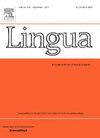Regional pragmatic variation in the use of conventional expressions at three Spanish-speaking sites
IF 1.3
3区 文学
0 LANGUAGE & LINGUISTICS
引用次数: 0
Abstract
This paper reports on an empirical investigation of regional pragmatic variation in the use of conventional expressions in Spanish at three sites: two in Spain (in the Barcelona and Extremadura areas) and one on the US-Mexico border (El Paso/Ciudad Juárez). Conventional expressions are multi-morphemic expressions and one type of pragmalinguistic resource. They are inherently social in nature and characterize language use within speech communities. Conventional expressions are associated with specific pragmatic situations and are the preferred expression of L1 speakers in those contexts. Data were elicited via computer-delivered oral production tasks from 107 L1 speakers of Spanish in the Barcelona (N = 38), Extremadura (N = 33), and El Paso/Ciudad Juárez (N = 36) areas. The tasks were regionally adapted so that speakers would feel that they were speaking to interlocutors from their respective speech communities. Conventional expressions were identified as occurring in at least 50% of the responses in any one community. Speakers in some sites used more conventional expressions than others. Some situations elicited the same expressions at all three sites, some show agreement at two sites, and some yield a different expression from each site. The sites show substantial overlap in expressions, although not in contexts of use (exhibiting variety-preferential variation rather than variety-specific variation).
在三个讲西班牙语的地区,传统表达用法的地区语用差异
本文报告了在三个地点对西班牙语常规表达使用的区域语用差异的实证调查:两个在西班牙(在巴塞罗那和埃斯特雷马杜拉地区),一个在美墨边境(埃尔帕索/城Juárez)。常规表达是一种多语素表达,是一种语用语言资源。它们本质上是社会性的,是语言群体中语言使用的特征。惯例表达与特定的语用情景有关,是母语使用者在这些情景中首选的表达方式。数据通过计算机传递的口头生产任务从巴塞罗那(N = 38)、埃斯特雷马杜拉(N = 33)和埃尔帕索/Ciudad Juárez (N = 36)地区的107名母语为西班牙语的人那里获得。这些任务是根据不同地区进行调整的,因此发言者会觉得他们是在与来自各自语言社区的对话者交谈。在任何一个社区中,至少50%的回答中出现了传统表达。有些地方的讲话者使用比其他地方更传统的表达方式。有些情况下,三个位点的表达相同,有些情况下,两个位点的表达一致,有些情况下,每个位点的表达不同。这些位点在表达上显示出大量的重叠,尽管在使用背景上没有重叠(表现出品种优先变异而不是品种特异性变异)。
本文章由计算机程序翻译,如有差异,请以英文原文为准。
求助全文
约1分钟内获得全文
求助全文
来源期刊

Lingua
Multiple-
CiteScore
2.50
自引率
9.10%
发文量
93
审稿时长
24 weeks
期刊介绍:
Lingua publishes papers of any length, if justified, as well as review articles surveying developments in the various fields of linguistics, and occasional discussions. A considerable number of pages in each issue are devoted to critical book reviews. Lingua also publishes Lingua Franca articles consisting of provocative exchanges expressing strong opinions on central topics in linguistics; The Decade In articles which are educational articles offering the nonspecialist linguist an overview of a given area of study; and Taking up the Gauntlet special issues composed of a set number of papers examining one set of data and exploring whose theory offers the most insight with a minimal set of assumptions and a maximum of arguments.
 求助内容:
求助内容: 应助结果提醒方式:
应助结果提醒方式:


